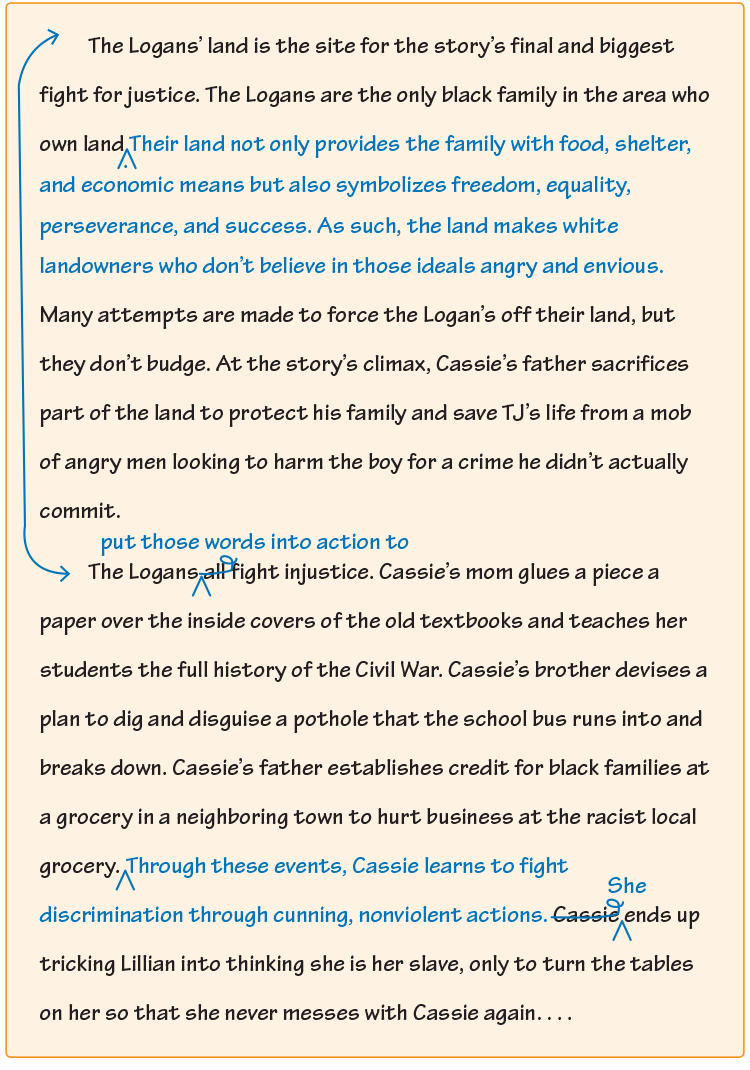Revising Literary Analyses
Nice job completing the first draft of your analysis! Take a short break before you begin revising. The time off will give you a fresh perspective on your first draft. Afterward, you can use the lessons that follow to turn a good analysis into a great one.
Revising for Thematic Details
You can deepen your analysis by adding thematic details. Theme is often the most challenging element to analyze in literature. That's because the big life lessons or morals of a story are not always stated outright. Instead, you as reader must infer those lessons by drawing conclusions from clues in the text.
Most stories include multiple themes, and different readers focus on different ones based on their own life experiences. You can discover themes by using any of the following strategies:
Consider clues in the title.
Roll of Thunder, Hear My Cry depicts how one young girl finds her own voice in speaking out against injustice and prejudice.
Follow the main character's words and actions.
Focus on a symbol, a metaphor, or another figure of speech.
Note when the narrator or a character offers a statement about life.
Focus on a key character trait, or show what a character learns.
Revise for thematic details.
Use the five strategies above to discover thematic details from your story. Decide which of these to add to your first draft, perhaps in the final paragraph.
Revising to Improve Organization
Your literary analysis should have a three-part structure: a beginning that gets the reader's attention and provides the thesis, a middle that explores the thesis with main points and supporting evidence from the text, and an ending that effectively wraps up the analysis.
In addition, the details in your middle paragraphs should follow a consistent order. If you use chronological order, you report details in the same time sequence used in the story. If you use order of importance, you arrange details from the most important to the least—or the other way around. The following graphics provide a visual representation of the patterns.

Transition words and phrases can help you connect ideas using one of these patterns of organization.
Chronological Transitions
about
after
as soon as
at
before
during
finally
first
in the end
later
meanwhile
next
second
soon
then
to begin
today
tomorrow
until
yesterday
Transitions for Order of Importance
additionally
again
all in all
along with
also
and
another
as well
besides
crucially
especially
finally
for example
for instance
for one thing
for that matter
importantly
in addition
indeed
in fact
moreover
most importantly
most important of all
next
obviously
significantly
to emphasize
truly
without question
undoubtedly
Revise for organization.
Use the following questions to check the organization of your literary analysis. Add, cut, rearrange, or rewrite parts as needed to improve organization. Make a copy of this Google doc or download a Word template.
- Does the analysis form a meaningful whole, with beginning, middle, and ending parts?
- Do the middle paragraphs follow a logical pattern (chronological order or order of importance)?
- Do the details within paragraphs support the idea in the topic sentence?
- Do transition words or phrases connect ideas?
Revising with a Peer Response
Share your writing.
Have a classmate read your review and complete the form. Make a copy of this Google doc or download a Word template.

Revising in Action
When you revise, you add, delete, rewrite, and rearrange your writing to make it clearer. Here are some revisions to the literary analysis of Roll of Thunder, Hear My Cry.
Revise with a checklist.
Read each line. When you can answer each question with yes, check it off. Make a copy of this Google doc or download a Word template.
Developing Your Ideas
- Does your analysis have a strong lead that will catch your reader's interest?
- Does your thesis statement clearly focus on one or more major elements of the literature?
- Does your analysis include thematic details?
- Does the topic sentence of each body paragraph name a specific main point that supports the thesis?
- Does evidence from the literature provide solid support for your analysis?
- Do transition words and phrases connect ideas and create a smooth flow of thought?
- Does your writing voice sound knowledgeable and interested?
- Do your sentences read smoothly?


